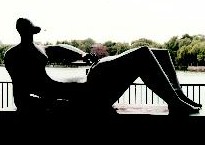 Henry Moore Sculpture Exhibition is now on the show in the National Art Gallery of China. The 106 exquisite sculptures of different periods and various styles bring one surprise after another to the visitors. Before the exhibition in the gallery, 12 large-scale outdoor sculptures were shown in Beihai Park, located in central Beijing, which attracted many visitors and in particular art students of different ages.
Henry Moore Sculpture Exhibition is now on the show in the National Art Gallery of China. The 106 exquisite sculptures of different periods and various styles bring one surprise after another to the visitors. Before the exhibition in the gallery, 12 large-scale outdoor sculptures were shown in Beihai Park, located in central Beijing, which attracted many visitors and in particular art students of different ages.
Born into a coalminer family in Castleford, Yorkshire of Britain, Henry Spencer Moore (1898-1986) later became one of the most outstanding and renowned sculptors in the history of modern Western sculpture, only after Augustin Rodin. Throughout the 1920s and 1930s he created with stone and wood. He was deeply influenced by 'primitive' sculpture, for example the art of ancient Mexico. After the World War II, he worked principally with bronze, thus producing many huge works. His art exerted great influences on the world in the 20th century and his works have been exhibited throughout the five continents.
The sculptures of Henry Moore are always shocking but also presents a kind of affinity. On the one hand, they are mysterious and vigorous, and on the other, they are simple and can be understood by everyone. His works can be basically divided into three categories: First, mother and son, which is the main topic of Moore throughout his life time. Second, reclining figures. The one piece he produced under the entrustment of UNESCO reached the peak in this field of artistic creation. Third, incomplete figures, always in a posture of standing, which depict soldiers and death. Most of them were made of bronze, his favorite material in later years.
According to Wang Duanting, researcher of the Institute of Fine Arts under the China Arts Academy, this is the fourth time that Moore's works come to China. The first time was in 1970 when the Henry Moore Watercolor Paintings and Sketches Exhibition held in Hong Kong. In 1982, Beijing hosted the British Sketches and Watercolor Paintings Exhibition. Three sketches of Henry Moore were on display. In 1986, when the master died, the Arts Exhibition of Henry Moore was held in Hong Kong, showing his sculptures, sketches and watercolor paintings. The exhibition this year is the largest one of Western sculptures.
The preparatory work for the exhibition lasted for three years. Experts said that the exhibits on display are worth over US$80 million. However, the exhibition in Beijing did not enthralled young people as expected.
Why so? Experts explained the reason as follows:
"We are perplexed about the Western modern art when three foreign painting exhibitions were held in Beijing in 1998, for Chinese audiences hadn't found a standard to evaluate them," said Chen Danqing, professor with the Arts College of Tsinghua University. "When our knowledge about Western art is still fragmented, we come across Henry Moore. The frustration is the same. I hope a better social environment will be set up soon in China to face both the Western and Chinese art." Chen also suggested the exhibition sponsors give a background material to audiences if conditions are available.
Some visitors were confused in front of Moore's works in the Beihai Park, guessing a work was a bear or a ghost. Sun Wei, deputy director of the Sculpture Department of Central Arts University, felt sorry about this. He said, "The duty is on us. We should have provided background materials of Moore for the audiences to help them have a better understanding of these masterpieces."
Qi Mai, PR manager of China International Exhibition Exchanges Center, pointed out that people cold-shoulder indoors exhibition because the 118 exhibits are divided. The 12 bronze works representing essence of Henry Moore are set into the scenic Beihai Park. The relatively wide space and free photo-taking attract more visitors. Also, the exhibition outdoors will go on until April next year. What's more, after the exhibition in Beijing, 106 indoors works will be transferred to Guangzhou and Shanghai, enabling more Chinese to see and feel the great Western artist.
(CIIC)
